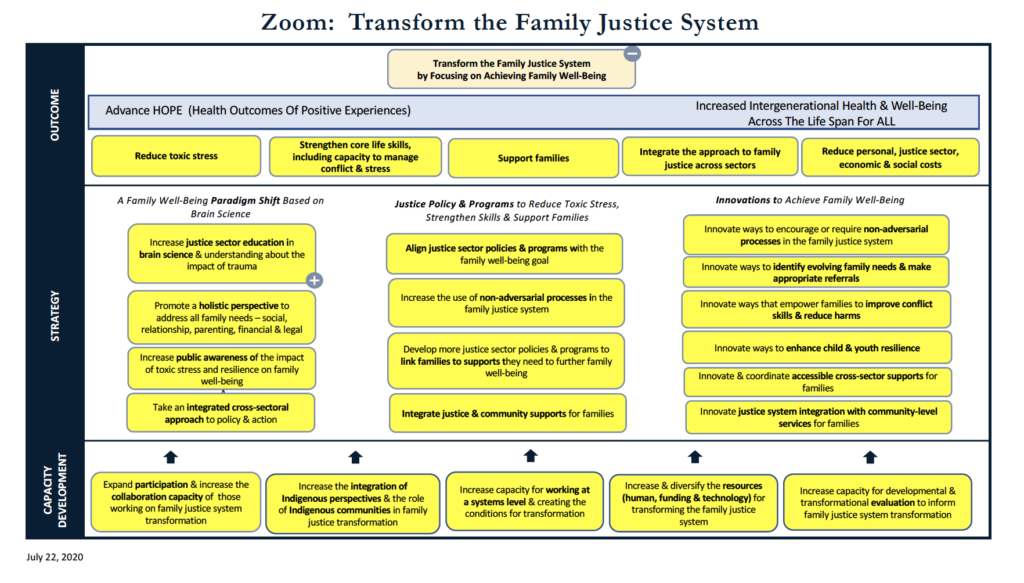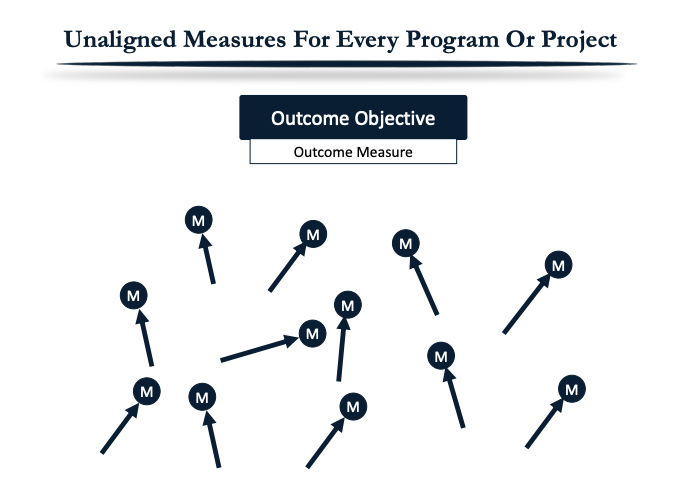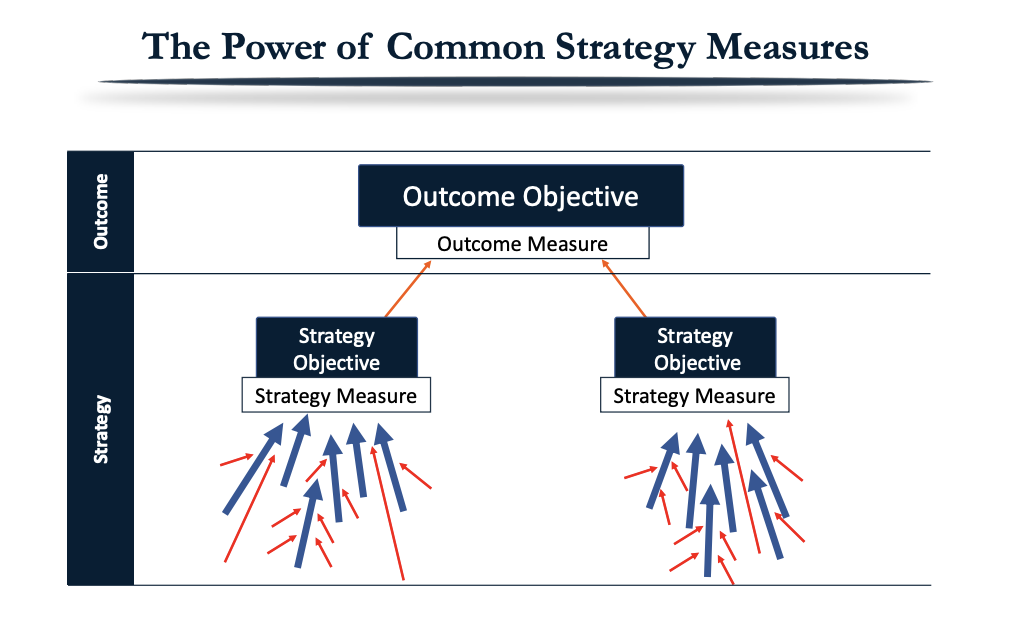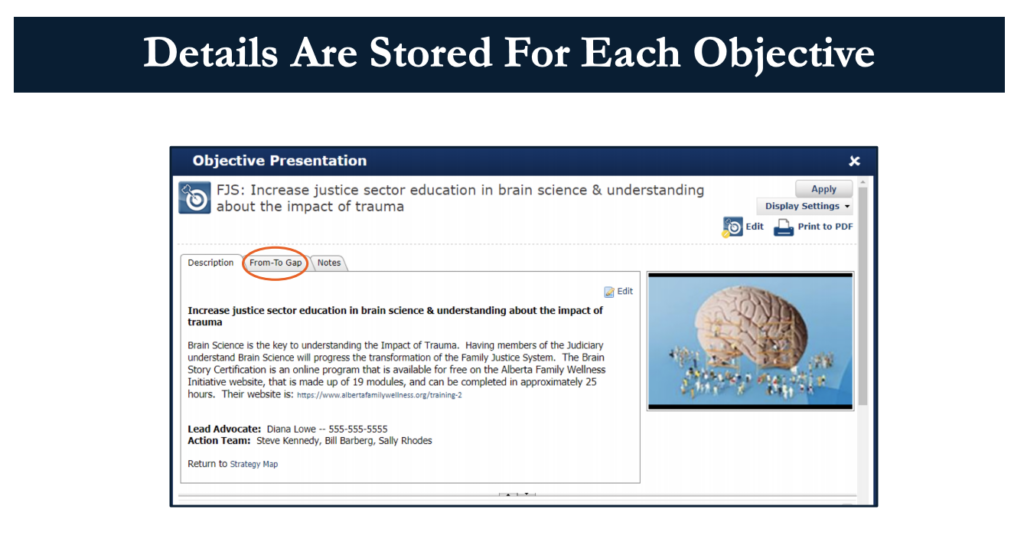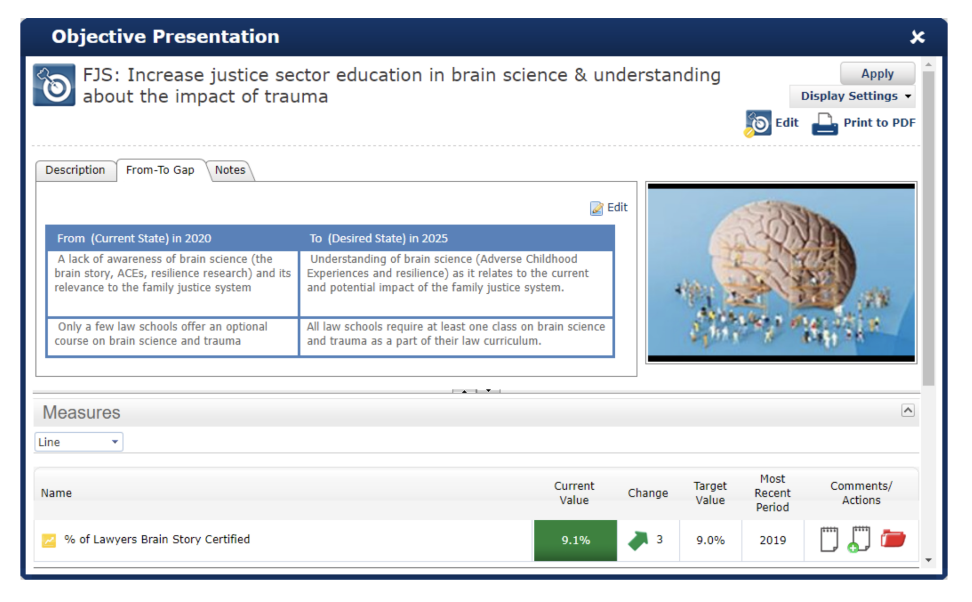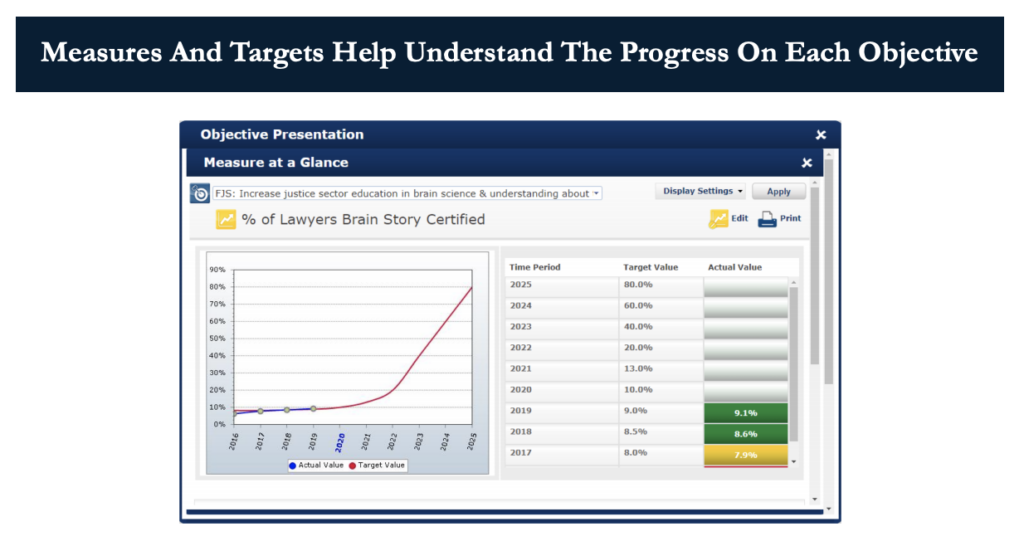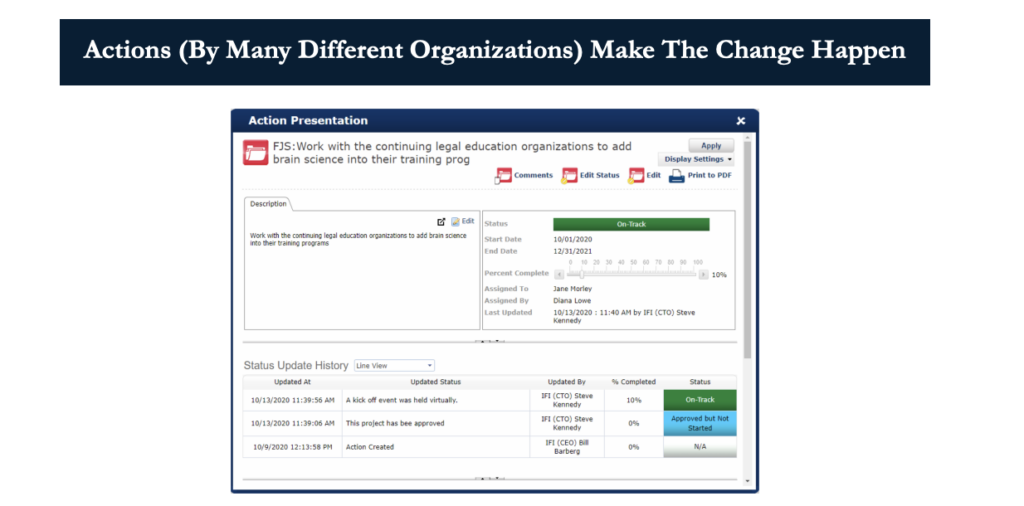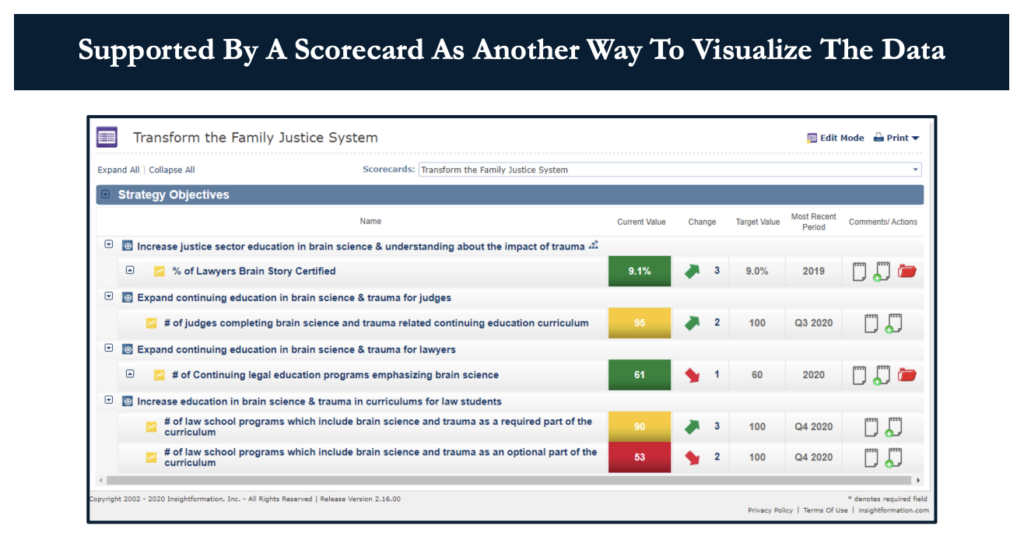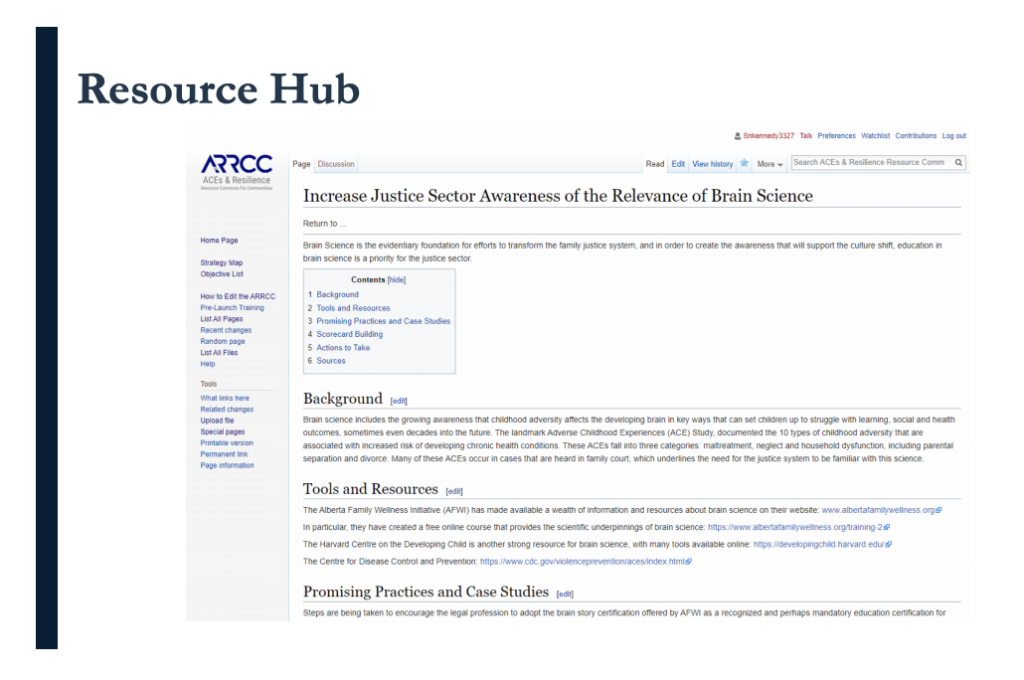Excerpt from the Report of the Working Group on an A2JBC Family Justice Leadership Strategy (November 2020).
Recommendation #4
Use a strategy map framework for the TFJS Collaborative, customized for British Columbia and connected to an ACEs and Resilience Strategy Map that links the Collaborative with organizations across many sectors
A strategy map is a visual representation of an aligned set of strategies intended to bring about change. It supports collaboration among multiple organizations working together to achieve an outcome.
The leadership strategy working group early on identified the need to provide a visual framework for the work of the Collaborative. This led to A2JBC’s strategic coordinator and some of the members of the working group collaborating with leaders of the Alberta Re-imagining the Family Justice System (RFJS) initiative and with a US-based organization, Insight Formation, on developing a “transform the family justice” objective in the context of a larger, cross-sectoral ACEs and Resilience Strategy Map zoomable template. (See Figures 10 & 11)
The first map sets out the high-level outcome objectives that are defined in terms health and well-being; strategy objectives, including circled in the bottom right “Transform the Family Justice System”. Zooming down, from this strategy objective to the next level, takes you to the second map that Alberta and BC worked on together, showing strategic objectives, directed at transforming the family justice system and divided into the three categories. These categories reflect the three levels of the Geels Framework for System Change (see Figure 2, page 4) and are referred to in the Theory of Change section, above:
- A family well-being paradigm shift (based on brain science)
- Policy and programs to reduce toxic stress, strengthen resilience, and support families
- Innovations to improve family well-being (experimenting, evaluation and scaling).
Insight Formation has been working in the world of collective impact for many years, and has developed strategy mapping, and tools related to it, to respond to the challenges of collaborative initiatives that are attempting to address complex social issues. Because of the work BC and Alberta have done over the last several months to help with the ACEs and Resilience Strategy Map, Insight Formation is working with both provinces to develop customized maps for each province, as illustrations of how strategy mapping can be used in the field of collaborative social impact initiatives. This led to Alberta and BC family justice strategy mapping work being used as an example in an article co-authored by Insight Formation principal Bill Barberg, John M. Bryson, Humphrey School of Public Affairs, University of Minnesota and Michael Quinn Patton, renowned author on evaluation in the context of social transformation. The article has been accepted for publication in the Journal of Change Management.
The strategy mapping approach is consistent with A2JBC’s commitment to a justice sector shift to being evidence-based. It includes developing common measures and setting targets for achieving those measures. To the extent that measuring is currently being done in the justice system, it is primarily individual measures that vary from program to program. (See Figure 12)
The strategy mapping approach develops common measures that are used by all the different organizations working towards the same strategic objective. (See Figure 13 – Note: the larger blue arrows represent the organizations in the Collaborative, the smaller reads arrows represent assisting organizations recruited to help achieve the objectives.)
Details about each objective on the strategy map can be stored in a parallel system/tool called “InsightVision” that holds not only the Strategy Map view (see Figure 11 above) but also has the ability to store all of the data relating to the work of the TFJS Collaborative. See Figure 14 for an example of a data page for one of the objectives “Increase justice sector education in brain science & understanding about the impact of trauma”. From this data page, it is possible to go back, with a click, to the Strategy Map or a click for more detail about the objective, including measures and actions.
Figure 15 shows what you see if you click on the From-To Gap on the Objective Data page, it includes a clear description of the change that the TFJS Collaborative is trying achieve related to this particular objective. Circled in the bottom left hand corner is an example of a common measure related to the particular objective, along with an indication of the degree to which the target related to that objective has been achieved.
Figure 16 shows the Measure at a glance, with details about the historical situation, the targets over time and the degree to which those targets are reached.
This kind of data can be tracked for any of the objectives. It gives a clear understanding of how the Collaborative is doing with the individuals actions that have been identified as helping to move towards the change sought.
Actions have their own data page. See Figure 17 below.
The InsightVision tool can track actions from many different organizations, all working towards the common objective on mutually reinforcing activities that fit with their resources and mandates. It can show who has been assigned to do the work and the status of each action. This can all be rolled up in a Score Card that creates yet another way to visualize the data. See Figure 18 below.
All the information is interconnected. A change in one part of the tool automatically makes a change throughout, thereby avoiding multiple entries.
A final resource, offered by the strategy mapping approach using the Insight Formation tools, is a Resource Hub that uses a wiki platform or commons. See Figure 19, below. This is a separate resource that is maintained by the organizations engaged in the Collaborative . It is a platform for sharing information about experiences working on the specific strategic objectives.
Participating in the Resource Hub related to the high-level ACEs and Resilience Strategy Map (Figure 10, above) is an opportunity for the BC justice sector to learn from and connect with organizations that are working on similar strategies across many sectors.
In summary, the reasons to adopt the strategy mapping approach are:
- It clarifies the larger, longer-term collective vision (necessary when addressing complex social issues) while, at the same time, encouraging short-term, decentralized actions.
- It provides a framework for mapping existing efforts and highlighting their alignment around common objectives.
- It encourages strategic networks of organizations working on common objectives, learning from each other and building solutions together.
- It incorporates measures and targets that can be recorded, monitored and made public.
- It is a tool for keeping track of different activities, and instilling a level of accountability without directing participating organizations what to do.
- It can be the repository of resources (or connection to resources) that will reduce duplication of effort.
- It builds on the work done together by BC and Alberta on a joint articulation of a family justice strategic objective. This opens up synergistic possibilities with Alberta and other provinces, and increases the options for funding.
- It will link the A2JBC justice sector initiative to the efforts of other sectors (for example, the mental health and education sectors) who are also working on the ACEs and Resilience Strategy Map template, and open up resources beyond the justice sector for understanding the issues and providing solutions.


